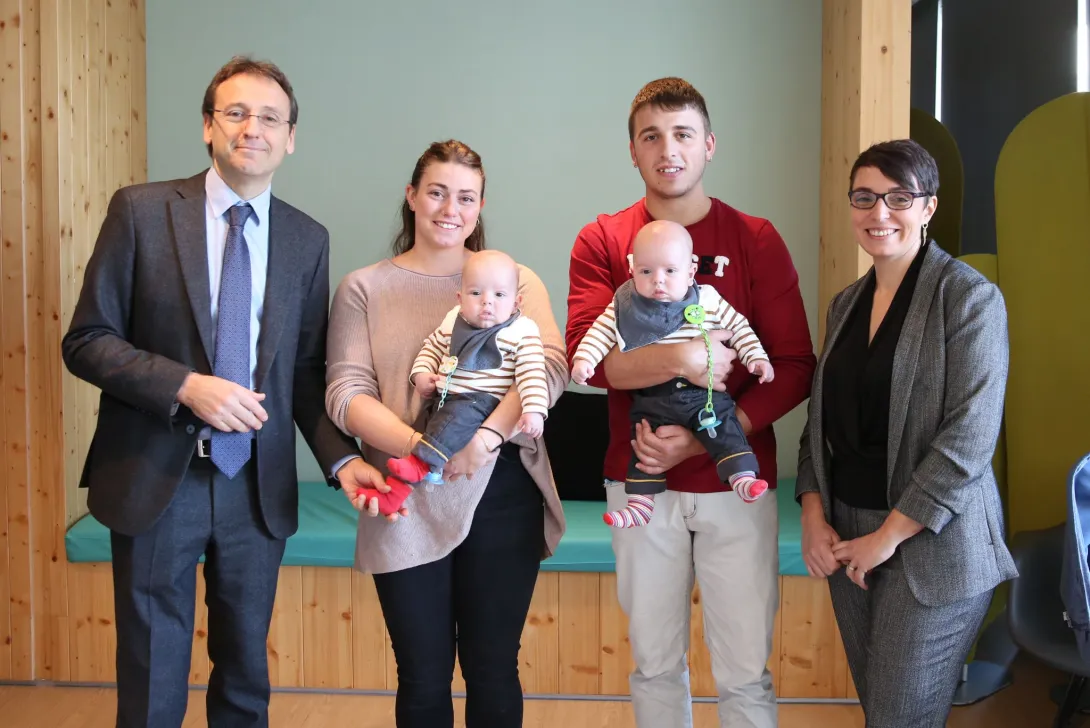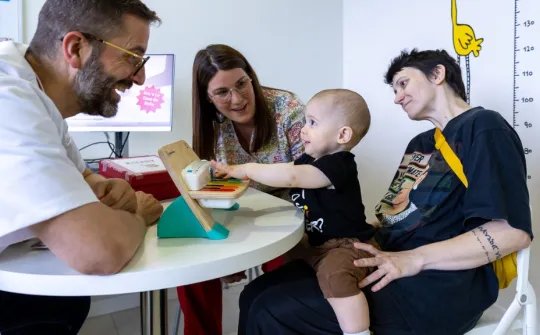We are pioneers in TTTS surgeries and research, developing studies, improving treatment techniques and classification systems.
Pathology description
TTTS is a serious complication that occurs in 10-15% of monochorionic twin pregnancies, which are pregnancies with identical twins sharing a single placenta, that is, in 1 in 2000 pregnancies.
Its natural evolution implies, in most cases, a high mortality rate during pregnancy or at birth. Early diagnosis and treatment at the right time are essential because they can save most of these pregnancies.
Why does it occur?
Currently there is no known genetic risk or factors of the pregnant woman such as diseases, drugs or toxins. TTTS occurs because two fetuses share the placenta and establish communications between their blood vessels through which they exchange their blood in an unbalanced way.
The placenta is the intermediate organ between the pregnant woman and the fetus. It implants and grows in the uterus where it receives the blood of the pregnant woman through arteries and veins that are dividing (or branching, like the roots of a tree). On the fetal side of the placenta, the arteries and veins join until they connect with the umbilical cord of the fetus. This blood circulation allows the fetus to obtain from its mother the nutrition and oxygen it needs.
In a monochorionic twin pregnancy each of the fetuses has a large part of the placenta that is specific to each one. But there is an area between the two that is shared. This is like two trees that have been planted close to each other and have connected roots. In fetuses these connections are from the arteries and veins that run through the placenta, and are called vascular anastomosis. Through these connections, the fetuses pass blood to each other.
In 85 to 90% of monochorionic twin pregnancies, this blood exchange between babies remains balanced throughout pregnancy. That is, each fetus ‘sends’ the other about the same amount of blood as it ‘receives’ from its sibling. But in 10-15% of cases there is an imbalance in the exchange.
At some point in time, one fetus begins to send more blood than it receives. This imbalance can be so significant that it ends up producing the problem we know as TTTS. Therefore, although connections between fetuses exist in almost all monochorionic twins, in only a proportion of them is TTTS generated. TTTS is a disease suffered by fetuses, but the problem originates in the placenta.
What are the consequences of TTTS?
In cases of severe TTTS, there is an unequal exchange of blood between the twins through the vascular communications of the placenta. The fetus that ‘gives’ more blood is called the donor and the one that ‘receives’ is called the recipient:
- The donor has a significant loss of blood volume. This causes the body to try to adapt and retain as much fluid as it can so as not to lose more, so it stops urinating. For this reason, we see a very small bladder and the donor fetus runs out of fluid in its sac (oligohydramnios).
- The recipient suffers the opposite problem, receiving too much blood so the heart needs to work above its normal capacity, and eventually going into heart failure. Therefore, the fetus urinates as much as possible to remove some of the fluid. For this reason, in the recipient we see the urinary bladder very large all the time and much more fluid than would be normal in its amniotic sac (polyhydramnios).
If not treated, TTTS has a very poor prognosis for both fetuses. Mortality is almost 100% and most cases that survive to birth are very premature, with a high risk of serious postpartum complications and long-term sequelae.
Diagnostic
TTTS is detected by performing an ultrasound. It appears quickly in many cases. For this reason, it is mandatory that monochorionic pregnancies are monitored with ultrasound checks every 2 weeks.
Ultrasound reveals the characteristic signs of TTTS if they are present:
- The donor fetus always has very little amniotic fluid (oligohydramnios) in its sac and it is not possible to see its bladder (which is normal in size, but produces almost no urine).
- The recipient fetus, on the contrary, has a large amount of amniotic fluid in its sac (polyhydramnios) and a very large bladder all the time, which reflects increased urine production.
Sometimes, a discrepancy in the size of the fetuses is observed, and if so, usually the recipient is larger than the donor. But this is not a TTTS criterion and should not be used for diagnosis.
Treatment
TTTS is one of the pathologies with the most successful treatment in fetal medicine, and in many cases it is possible to cure the disease. For this reason it is very important that the diagnosis and treatment come as early as possible.
The treatment is the laser coagulation of vascular communications between fetuses by endoscopic surgery (fetoscopy), via a 3 mm tube through which you can visualize the inside of the uterus, see the placental vascular connections that are producing the problem and destroy them with a laser.
It is a very low invasive treatment for the pregnant woman, and discharge is usually possible the day after the intervention. Overall, it is possible to reverse the situation and go from a survival of almost 0% to a situation in which at least one of the twins survives in approximately 80% of cases.
Early diagnosis, the experience of the centre and the duration of the surgery are key factors to ensure the best results.

What appointments are necessary for fetal surgery?
The inpatient admission of the pregnant woman will initially last 1-2 days, and then weekly examinations and ultrasound will be required, and until the end of pregnancy she must rest at home with little physical activity, especially for the first 3-4 weeks after the intervention. Normally, delivery can be performed between 34 and 36 weeks of gestation.
During pregnancy, you will receive the support of nurses specialized in fetal medicine, not only on a technical level but also on an emotional level throughout the process. In addition, we can put you in contact with other families who have gone through the same experience. This is very positive and helps to humanize and understand the problem in a much more intuitive way and without the difficulties that sometimes arise when receiving only technical information from professionals.
Why SJD Barcelona Children's Hospital?
We are one of the teams with the most surgical experience in the world, having performed more than 2000 fetoscopies for complications of monochorionic twin gestation.
Experience and efficiency
We are one of the teams with the most surgical experience in the world, having performed more than 2000 fetoscopies for complications of monochorionic twin gestation.
- Our surgeons are among the pioneers of fetal surgery for TTTS in Europe and the world, and have been part of the expert groups that have defined the diagnostic criteria currently used. Dr Eduard Gratacós performed the first treatment in Spain.
- Currently, in the TTTS groups with the best prognosis, we achieve survival rates for at least one of the two fetuses of close to 95%.
- We use techniques that allow us to operate in situations where the placenta is anterior, so that the results of our team are the same regardless of the location of the placenta.
- We have refined the TTTS endoscopic surgery technique by integrating navigation and robotics tools and technologies that allow for greater precision and speed during surgery, reducing associated complications.
We are one of the groups that have done the most research on TTTS internationally, developing studies and classification systems.
Commitment to research
We are one of the groups that have done the most research on TTTS internationally, developing studies and classification systems.
- As a high-level research group, we develop innovations that have resulted in improvements in forecasting, speed and safety.
- We use our own calculators that allow us to estimate very precisely the chances for each fetus. This information is very important to consider the best treatment together with the parents.
- We have published our figures and our surgical times, which are among the lowest reported in the medical literature, in numerous studies. Shorter surgery times are also associated with better results and very low rates of complications.Currently, we achieve survival rates for at least one of the two fetuses of close to 95% in the TTTS groups with the best prognosis.
- We have refined a technique for endoscopic surgery of TTTS in which tools and technologies of navigation and robotics are integrated that allow greater precision and speed during the surgery, reducing its total time and, with this, part of its associated complications.
